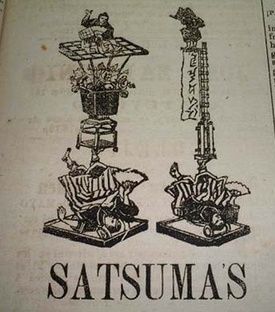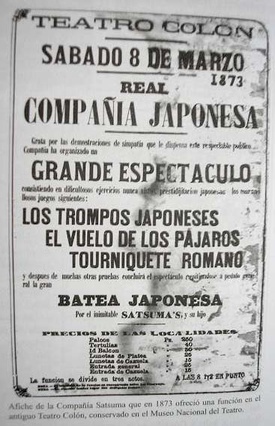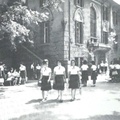The first Japanese to step foot in Brazil were the four castaways on Wakamiya-maru who arrived at Santa Catalina Island in 1803 by Russian warship. But they simply passed by.
The first Japanese to land on Brazil at the end of the Tokugawa shogunate were Takeaki Enomoto and other members who were sent abroad on Kaiyo-maru as shogunate students. On October 25, 1866, they left the port in the Netherlands, passed through Rio de Janeiro, and returned home at the Yokohama port in March of the following year, 1867.
The first Japanese who “had their bones buried” (a Japanese expression meaning to spend the rest of one’s life) in Brazil was a samurai warrior of the Satsuma Domain Jyurozaemon Maeda who committed suicide by disembowelment on a British warship off the coast of Bahia Bay in 1870 (Meiji 3).
The first Japanese ever to travel to Brazil since the opening of Japan is said to be Wasaburo Otake, who crossed the ocean on the Brazilian warship “Almirante Barroso.” The ship arrived in Yokohama in July 1889 and returned to Rio de Janeiro on July 29, 1890.
It was just after the monarchy of the Empire of Brazil was overthrown by a military coup (November 1889), followed by the proclamation of the Republic.
The year 1889 was an important one for Japan as well. It was the year in which the proclamation of the Meiji Constitution was issued, adopting the demand of the Freedom and People’s Rights Movement. The Imperial Diet was first held in the same year and was continually conducted afterwards, constructing the backbone of Japan.
It was definitely an early time to come to Brazil. The first immigration ship Kasato-maru arrived in 1908, so their trip took place nearly 20 years before that.
However, if we look at the studies conducted by researchers from both Uruguay and Argentina, we can see that some Japanese might have come over to South America in 1873 (Meiji 6), which could have been the first since the opening of Japan. What kind of Japanese people made such a move to go all the way to the other side of the earth, to South America in Meiji 6? It turns out they were acrobats.
In the late Edo period, the first passports were issued to a group of acrobats. It was for performing shows in Europe and America, and they even got to shake hands with the U.S. President before the Meiji Restoration took place.
Performing in Uruguay in January 1873
According to the report by Naomi Maeda who lives in the capital city of Oriental Republic of Uruguay, Montevideo, Satsuma Company (the acrobatic group) performed at Solís Theatre in the capital city in January and February of 1873 (Meiji 6). These performers, acrobats, and magicians performed ten shows during the period between January 29 and February 21.
We can say for sure that a group of Japanese acrobats had a performance in South America as early as in Meiji 6.

A local paper in Uruguay, El Ferrocarril Montevideo, reported on January 29 of the same year: “Satsuma Company to perform in Montevideo prior to shows in Europe.” On February 2, they published an article about Japanese geography, history, and culture. In the February 6 issue, they wrote, “Magician Yasso wins applause for the handling of 50 needles on stage.”
The performance on February 21 is said to have been dedicated to José Ellauri (who was speaker of the Senate at the time and became President the following month). (From Naomi Maeda’s research: Resources Department of Municipal Solís Theatre (CIDDAE) and “El Ferrocarril Montevideo” published in 1873, archived at National Library.)
Performing in Argentina in March of the same year

According to the first part of The History of Japanese Immigrants in Argentina (History of Japanese Immigrants Compilation Committee, 2002), this Satsuma Company performed at the then Colón Theatre in Buenos Aires in Argentina after they performed in Uruguay.
The promotional poster of their show, which is dated March 8 (Sat.), 1873 (Meiji 6), can be found at the National Theatre Museum. It was not posted at the prestigious Colón Theatre; instead, it was posted at a more casual and common theater in a different location where people enjoyed performances of circuses, dramas, songs and dances, acrobatics, and so on.
We can naturally assume that their next destination would have been Brazil, given that they had been to Uruguay and Argentina; unfortunately, I haven’t been able to find any articles in my searching so far. As I kept looking at different sources, however, I did find some traces of them.
When did Satsuma Company leave Japan?
In the passport dated Keio 2 (1886)1, it’s noted that “during the restoration period in the late Tokugawa Shogunate beginning in Keio 2, upon lifting of the ban on traveling overseas, many strolling performers including not only Sumidagawa Namigoro Company and Matsui Gensui Company, but also Satsuma Company, Hayatake Torakichi Company, Torigata Kosankichi Company and others went abroad.” So, it was Keio 2 (1866) when they left Japan.
Furthermore, it says that “a number of Japanese performers went overseas after the Meiji Restoration and in 1872 (Meiji 5), a delegation group led by Iwakura Tomomi that was sent to America and Europe is said to have met a few acrobats in New York who identified themselves as “Satsuma.” This “Satsuma” Company could have traveled south and stood on stage at Colón Theatre in Buenos Aires in 1873.” (on page 19 of the same History of Japanese Immigrants in Argentina)
There is an anecdote of Satsuma Company that when they ran into the Tomomi Iwakura delegation group on Fifth Avenue in New York, they knelt down on the stone pavement ground out of the blue, astonishing American passersby around them.
I also found this note: “there is this group called ‘Satsuma Company’ that, after touring around in the United States, came all the way to Australia at the end of 1870.”2
Satsuma Company presumably traveled to Australia, after touring in the U.S. They might have returned to the U.S., decided to travel south and reached Chile and Peru in 1872.
In January 1873, they arrived in Uruguay and Argentina. The reason might have been that they couldn’t quite achieve success in America and Europe, so they traveled down to South America.
Notes:
1.「慶応2年のパスポート(Passport dated Keio 2 [1886]) 」(Accessed on March 31, 2016).
2. Mitsunobu Matsuyama, 「異国の舞台に立った日本人一座を追って ―南半球に向かった開国直後の人々― (Following the trace of a Japanese group of entertainers who performed on stage overseas—those who headed in the Southern Hemisphere right after the opening of Japan)」(Accessed on March 31, 2016)
© 2022 Masayuki Fukasawa





